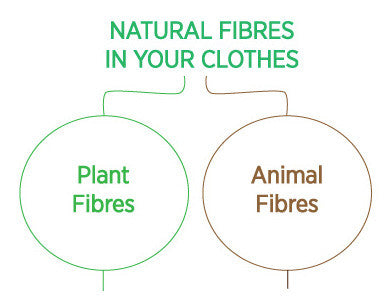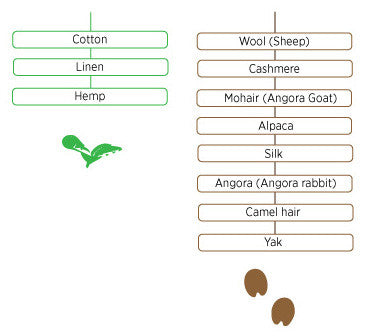If, as a society, we are to begin to see clothes in a different way, a way that places value on craft, skill and quality rather than disposability, one thing that can be easily communicated by brands and understood by consumers, is the fibres a garment is made of.
Knowing where your clothes were made and who made them is a fantastic thing but knowing what they are made of and therefore understanding how to care for them, as well as how they might age over time, are also useful things to know when weighing up a purchase.
Fibres used in clothing can generally be split into two types ‘natural’ and ‘man-made’. They are spun into yarn, which can then be woven or knitted to make a clothing fabric or finished garment.
What is a natural fibre?

Plant fibres are collected from the seed cases, leaves or stem (bast) of a plant. These are cellulose-based fibres.
An animal fibre consists of the hair, fur or natural secretion (silk worm) of an animal. These are protein-based fibres.
It’s important to note that just because an item of clothing may be made of natural fibres does not necessarily mean it has not come into contact with chemicals somewhere along the processing chain
Which natural fibres are often used in our clothes?

There are of course additional natural fibres used in textiles. The above graph outlines some of the most common of the natural fibres found in our clothing.
Cotton is the most extensively used natural fibre.
What are some of the environmental issues surrounding natural fibres?
- Water consumption (particularly conventional cotton)
- The use of pesticides and/or other chemicals in the growing and processing stages
- Land use and overgrazing (cashmere goats in particular)
In the manufacture of animal fibres, animal welfare (e.g mulesing) must also be considered.
What are some of the pros and cons of natural fibres for us as consumers?
Pros
- Can discourage sweating by being naturally breathable
- Often more comfortable against your skin
- Fabrics often age well
Cons
- Might wear out quicker
- Can be more expensive to buy
- Often more difficult to care for (e.g. wool can felt, cotton and linen wrinkle easily and silk needs to be handled delicately)
While animal and plant fibres are biodegradable (subject to how they are processed) and renewable resources, the rate at which we produce and consume them (often resulting in overgrazing and extensive land use) is not sustainable.
Check out my post on man-made fibres to get a broader grasp of the fibres listed on your clothing labels.
Like this post? Tweet it!
The aim of all of the posts in the DISCOVER section of STUDY 34 is to give you the knowledge to empower you to make better choices when buying clothing. By simplifying parts of the fashion industry that may seem complicated, I aim to inspire you to take more of an active interest in the stories behind your clothing.
Other STUDY 34 posts that may interest you:
